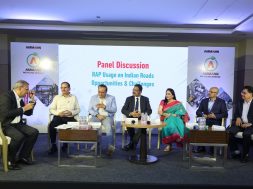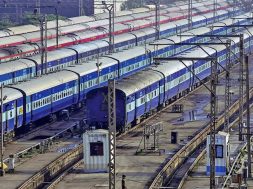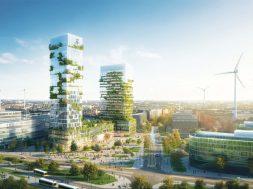KOCHI METRO New avatar in GOD’S OWN COUNTRY
Kochi Metro Rail project, the much anticipated and long cherished dream of Keralites, being developed in the vision to be a world-class metro rail system enhances the quality of life for the citizens of Kochi. In an exclusive interview with Subhajit Roy; TOM JOSE, IAS, Director of Kochi Metro Rail talks about his vision for the project which is still in its initial stages
Please update us about the ambitious Kochi Metro project.The Government of Kerala has recently established a special purpose vehicle, Kochi Metro Rail Ltd, which has been registered and we are expecting the certificate of incorporation shortly. The office location has been finalised and should be ready in a few weeks time. Meanwhile the preparatory work has begun with the reconstruction of north overbridge on Salim Rajan Road near the Kochi bus depot.
We are also planning to start some of the other preparatory works because while we do the main civil work, the traffic will have to be re-routed. For that purpose, some of the roads which have been identified as alternate roads have to be spruced up, they have to be resurfaced and some bridges will have to be built. On the other side we have taken up the issue of clearances with the Government of India which is under discussions. We are expecting the required clearances in few weeks.
Could you name some of the roads which will be diverted?There are two bridges which regulate the entry into the heart of the city. One is the north over bridge and the south over bridge. Since the Metro line passes over the north overbridge, that bridge has to be dismantled and reconstructed.
What is the expected date of completion for the entire project for Kochi Metro Rail?We are looking at 4 years from the date of all the clearances received. So if we get the clearances at the earliest, we can expect the Kochi Metro to be ready approximately by middle of 2015.
What is the planned expenditure for the entire project as of now? Could you brief us about the funding options?The planned expenditure is about Rs.4,427 crore. With reference to the source of funding, we envisage an equity participation of 15 per cent each by the Central and the State government, with the rest of the capital to be raised through loans and other debt instruments. In addition, we have subordinate debt which is about 11 – 12 per cent. We also plan borrowings and that debt would be around 52 per cent. That is how the funding is envisaged.
So far, the Kerala government has decided to allocate some amount of land which would come to around 5 per cent as its contribution. The state government has already sanctioned Rs.25 crore for the preliminary expenses and another Rs.158 crore for preparatory works.
How are you going to refund the borrowings?Basically, the refund will be through the ridership. We have worked out a viability analysis and have calculated the internal rate of return (IRR) to be around roughly 7 per cent provided we are able to raise loans from overseas banks. The IRR for overseas banks is around 7 per cent whereas in the case of Indian banks nothing is available for less than 11.5 per cent. Other than that, we are also looking at cross subsidising by means of real estate development.
Have you zeroed in on any overseas bank?We have had preliminary discussions with a Japanese Bank called JICA which is funding Chennai Metro as well. They have shown key interest in the project. We also had discussions with the finance ministry as all the overseas funding will have to be routed through them.
While the cost is always in the escalation, will it be possible to complete the project in the stipulated time frame using the planned expenditure of Rs.4,427 crore?For every project there is a cost and project overrun. Right now Rs.4,427 crore has been envisaged taking into account cost escalation up to 2014. If it gets spilled-off into 2015 then there could be a 5 – 6 per cent overrun.
How far the land acquisition has been done for this project?We have put all land acquisition related to Kochi Metro on the fast track procedure. Therefore, we will be able to save some time and we are looking at constituting district level purchase committees under the chairmanship of the district collectors so that we could have a negotiated purchase. This would encourage people not to uproar the codes and repay the cost of land acquisition. Besides we are also planning a rehabilitation and resettlement package which will certainly speed up the land acquisition process.
Is there any agricultural land coming into the route?There is a little bit where the depots have to be built. Other than that, the entire route is along the major roads. We are not disturbing the coastal region as well.
You are not using any PPP for this project, why?Private investment would not be a viable option for Kochi Metro Rail as the project is unlikely to generate attractive profit. Any private individual or private company that is investing today is looking at nothing less than 13 per cent internal rate of return after taxes as the cost of funds in the domestic markets are higher than 12 per cent. Taking everything into consideration, we expect the viability gap funding works out to 20 – 30 per cent of the project cost. So, it makes a lot of sense for the government to invest in major infrastructure projects like this because the way private sectors sees it, it is not attractive to them.
But we are not completely ruling out any private participation. If at a later stage we can accommodate private sectors, we would certainly be happy to do that. As of now, we have not found any private player who is willing to come to less than 15 per cent.
What kind of funding are you expecting from JICA?We are looking at 51 – 52 per cent of the planned expenditure. Basically it will be a 30 year loan with a moratorium for the first 10 years and we start paying off after the first 10 years. During the course of the next 20 years we expect to pay off the entire loan.
How safe are our Metro Rails taking into account the accidents that are taking place? What are the safety measures taken into account?Safety is of paramount concern. We will be going strictly according to the safety norms put forth by the safety commissioner of Indian Railways because safety commissioner has the task of ensuring that all rail projects are done in a safe manner according to the established procedures.
As you have already started thinking of alternate roads, what are the safety measures that can be taken to avoid accidents without traffic congestion?During the construction period, the sites will be totally barricaded and cordoned off as a separate place of activity where only the authorised person will be allowed. The State police have agreed to regulate the traffic alongside the construction site in such a manner so as to cause minimum inconvenience to motorists as well as to the nearby shops and localities.
What will be the total length of the route? What will be the maximum passenger carrying capacity?The Kochi Metro will run across 23 stations covering a distance of approximately 25 kms. It will start from Alwaye and goes to Thrippunithura. The interval of trains will be 4 – 6 minutes with 3 coaches per train, we can probably increase to 6 coaches depending upon the requirements but the infrastructure will be of 6 coaches. With 6 coaches each coach will be able to carry 200 passengers with 6 coaches, it will be around 1200.
What sort of arrangement do you have with Mr. Shreedharan led DMRC?DMRC is our principal consultant for this project, we have also entrusted them with our initial preparatory works which is under progress. We are in frequent touch with Mr. Shreedharan and DMRC has agreed to share its knowledge with us.
How do you feel about your new role in the Kochi Rail project?I am very excited and feel great to get an opportunity to do something which is really creative and which people of Kerala truly deserve. We have had great support and expectations from the people are also high. When we launched our website, within couple of days we received more than 100 mails with various suggestions, opinions and queries. We are also committed to maintain transparency by responding to every query posted on our website which is a major drawback as far as the government websites are concerned. The response from the public has been tremendous. We believe it as a people’s project.
We all are aware of IAS officer V J Kurian’s toil in building the Cochin airport. And again you are in the making of another landmark – Kochi metro. How do you see the role of IAS officers in infrastructure building especially in Kerala?I think, for a large infrastructure project like this, one needs to deliver his/her best. It is not a project that can be accomplished in the normal routine government department style. I think many a time the mistake we commit is that we tend to treat projects as any other government department activity, which has to be avoided. It has to be dealt with more professionalism because quicker decision making and very active monitoring are warranted. Any major project is a full time project and I think most of our IAS officers are quite capable and given the opportunity we can certainly perform.
What is your inspiration for the project?I have always felt that we are not doing enough to provide adequate infrastructure for the people especially when we look at the rapidly developing countries like China and others. We have to catch up with them and to do that we have to double the speed in infrastructure building. Therefore, I think, the idea came out as a desire to commit to my State for better infrastructure.
On completion, how do you see this project helping Kochi city and Kerala as a whole?Basically we are going to provide connectivity to people to carry on with their day-to-day businesses while saving a lot of time in travelling and offering quality of life. Our vision for this project is – to be a world-class metro rail system that enhances the quality of life for the citizens of Kochi.
Quick facts about Kochi Metro
Total length 25.523 kms
Total estimated cost is Rs.4,427 crore
Metro trains will have three to six cars
Each car can accommodate around 200 passengers
Will travel upto a speed of 50 kmph
Standard gauge rail of 1,435 mm width will be used
Alignment has been planned to keep acquisition of land to a minimum. Only 15.9959 hectares of private land need to be acquired
From station to station the running time will be approximately two minutes
The total running time from Aluva to Petta will be approximately 50 minutes. By road Tripunithura to MG Road takes 2 hours during peak hours and Alwaye to MG Road takes more than 2 hours. These distances will be covered in 15 minutes and 30 minutes respectively.
Cookie Consent
We use cookies to personalize your experience. By continuing to visit this website you agree to our Terms & Conditions, Privacy Policy and Cookie Policy.









